

Original Article - Year 2015 - Volume 30 -
Plastic surgery in the media: the concept of the specialty, as reported by the print media in Brazil
A cirurgia plástica na mídia: o conceito da especialidade veiculado pelos meios de comunicação impressos no Brasil
ABSTRACT
INTRODUCTION Besides the diverse situations in which plastic surgery is performed, the procedure has an aesthetic character associated with societal issues, related to the ideals of beauty and to the search for body perfection. Currently, specific body measurements are increasingly being given importance, and shown by the media as being associated with success at diverse social levels. The objective of this study was to identify the concept of plastic surgery, as reported by the print media in Brazil and available in the virtual environment, by analyzing and describing the type of information that is reported to the general public.
METHOD: For the data collection, a systematic search was performed on all news articles published by the print media in Brazil and available in the virtual environment. For the search, the descriptor used was "cirurgia plástica" ("plastic surgery" in English) in Portal Interjornal®. All news articles containing the term "plastic surgery" published between January 2008 and December 2011 were included in the study. The selected news articles were read and subjected to a previously established protocol.
RESULTS: A total of 1983 news articles were analyzed. From this total, 1367 (68.94%) were classified as aesthetic related, 423 (21.33%) as being associated with reparative surgery, 47 (2.37%) as aesthetic and reparative, and 146 (7.36%) as undetermined.
CONCLUSION: The concept of plastic surgery reported by the media was generally associated with aesthetic surgery. Both the content and the quality of information provided by the media are not enough to adequately clarify to the public the real role of the specialty and the care that should be taken when undergoing any type of surgical procedure.
Keywords: Plastic surgery; Journalism; Media.
RESUMO
INTRODUÇÃO A cirurgia plástica, apesar das diversas situações em que atua, tem o caráter estético difundido na sociedade, associado aos ideais de beleza e à busca das pessoas pela perfeição corporal. Atualmente, as medidas corporais são cada vez mais detalhadas, exibidas pela mídia como sucesso nos mais diversos âmbitos sociais. O objetivo do presente estudo será identificar o conceito de cirurgia plástica vinculado aos meios de comunicação impressos do Brasil e disponíveis virtualmente, analisando e descrevendo o tipo de informação veiculada ao público leigo.
MÉTODO: Para a coleta de dados, foi realizada busca sistemática de todas as notícias publicadas em meios de comunicação impressos do Brasil e disponíveis virtualmente. Para a busca, utilizamos o descritor "cirurgia plástica" no Portal Interjornal®. Foram incluídas no estudo todas as notícias publicadas entre janeiro de 2008 e dezembro de 2011, que contêm o termo "cirurgia plástica". As notícias selecionadas foram lidas e submetidas a um protocolo previamente definido.
RESULTADO: Foram analisadas 1983 notícias. Deste total, 1367 (68,94%) foram classificadas como estéticas; 423 (21,33%) como reparadoras; 47 (2,37%) como estéticas e reparadoras, e 146 (7,36%) como não classificáveis.
CONCLUSÃO: O conceito da cirurgia plástica veiculado pela mídia está geralmente associado à realização de procedimentos estéticos. Tanto o conteúdo quanto a qualidade das informações disponibilizadas pela mídia são insuficientes para esclarecer o público de forma adequada sobre o verdadeiro papel da especialidade e os cuidados que devem ser tomados ao se submeter a qualquer tipo de procedimento cirúrgico.
Palavras-chave: Cirurgia plástica; Jornalismo; Mídia.
The Brazilian Society of Plastic Surgery (SBCP) describes plastic surgery as a surgical specialty responsible for reconstructing body structures that show changes in their shape or function, e.g., deformities due to either congenital or acquired reasons. This specialty has the purpose of reshaping tissues, with the aim of obtaining a result as close as possible to normal while reestablishing the tissue function and appearance. According to the SBCP, aesthetic plastic surgery is mainly used to improve the appearance and self-esteem of the patient, whereas reparative plastic surgery prioritizes functional correction while aiming to provide the patient a close-to-normal appearance in the affected region1.
There is a wide range of situations for which plastic surgery is performed, such as burns treatment, hand injury treatment, breast deformity reconstruction, reconstruction after cancer ablation and for cranio-maxillofacial deformities, microsurgical transplantation, and treatment of acute and chronic wounds.
Despite its diverse applications, the aesthetic character of plastic surgery is widely known. This character is associated with the society's ideals of beauty and with the search for body perfection. The ideals of a perfect body are rooted in the cultural heritage of a society, its traditions, and evolutionary history. By analyzing the past, it is clear that women who would be considered as obese by current standards have already been idolized2. Nowadays, specific body measurements are increasingly being given importance, and are shown by the media as being associated with a person's success at diverse social levels. The advantages are countless for those who subscribe to the ideal body guidelines: admiration from others, longevity, financial success, and sexual accomplishment2. It is not only a matter of enhancing health and realizing the importance of having a normal body mass index (BMI) or waist size; the media, in general, has focused on the so-called ideal measures: large hips, large breasts, and face without any trace of aging. The ideal image is to be slim, "model-like," without fat, and youthful2. Therefore, there is an idea that the perfect body exists and that it can be attained according to the information disseminated through the media. The search for the ideal body operates through a number of discursive practices that are produced as games of truth. To construct these undeniable discourses, renowned professionals, research work from respected institutions, or persons with a similar experience are consulted2.
The Instituto de Pesquisa Datafolha performed a screening from September 23 to December 23, 2008, with 366 interviews among a population of 3533 associate and full members of the SBCP about the procedures they had performed. According to the institute, 73% of the surgical procedures were conducted with an aesthetic purpose, in contrast to 27% reparative/reconstruction procedures, i.e., for each reparative procedure performed, there were 2.3 aesthetic procedures. However, in that study, although not under the scope of surgery practice, the most often performed procedures were filling and the application of botulinum toxin, which are also related to aesthetic surgery3.
Reid and Malone4 demonstrated that, among 1191 articles reported by U.K. newspapers in 2006 in which the term "plastic surgery" was mentioned, 89% (1056 articles) used the term under the scope of aesthetic surgery, with only 9.5% (113) relating it to reparative surgery and 1.8% (22) to procedures classified as "others." Among the 113 articles related to reparative surgery, 83 were associated with trauma, 21 with burns, 3 with cancer, 5 with infections, and 1 with craniofacial surgery.
According to the Instituto Pró-Livro, 85% of Brazilians reported to watch television as entertainment, when questioned about leisure activities in 2011. Still in that study, 28% reported reading and referring to newspapers, magazines, books, or the Internet. Among these, 58% reported to read frequently5.
Concerning the investments made in advertising in Brazil, in the first trimester of 2012, there was an increase of 13%, equivalent to more than 4 billion reais. The channel TV aberta accounted for 65% of the expenses, followed by the newspapers (11%), and thereafter magazines (5.5%) and the Internet (5.29%)6.
As previously described by Reid and Malone, there is a relation between the types of plastic surgery (aesthetic and reparative) and the way English media reports the concept of this specialty4. However, in Brazil, a reference country in this specialty and where the population is in constant contact with media, this type of relation has never been described; therefore, conducting this work is a necessity.
OBJECTIVES
The objective of the present study is to identify the concept of plastic surgery as reported by the print media in Brazil and available in the virtual environment, by analyzing and describing the type of information that reaches the general public.
METHODS
The present work is a descriptive cross-sectional study conducted from August 2012 to July 2013, in Salvador, Bahia, Brazil.
For the data collection, a systematic search was performed for all the news articles published in print media in Brazil and available in the virtual environment. For this purpose, we used the descriptor "cirurgia plástica" ("plastic surgery" in English) in Portal Interjornal® - a search engine that allows finding information in the Brazilian press by date, period, word, or topic.
As the inclusion criteria for the study, news articles published between January 2008 and December 2011 that contained the term "plastic surgery" were considered. The period of publication of the news articles had a relevant sample size as criteria, according to a previous study4. The exclusion criteria were as follows: news articles not containing the search term in the text, and articles that did not originate from newspapers or magazines, such as those from blogs or sites where information is only available in the virtual environment and not in print.
The selected articles were read and subjected to a previously described protocol (Appendix A) by four of the authors, to classify and characterize the obtained content. The news articles analyzed by each author were selected randomly, without a selection criterion, and the same topics were analyzed by the same authors.
According to the protocol, we classified as "aesthetic" any news article in which the context referred uniquely to the concept of beauty and improvement of appearance. On the other hand, news articles that only mentioned functional recovery, or procedures considered as repair related, were classified as "reparative." Articles that described beauty concepts, improvement of appearance, and functional recovery were considered as "aesthetic and reparative," with this being a third classification. In case the text did not make reference to any of the previously described concepts, the news were considered as "undetermined."
To characterize the news, the following criteria, when present, were used: the relation between the term "plastic surgery" and famous people and television programs; the type of procedure cited (surgical or nonsurgical); the presence of guidelines from the Brazilian Federal Council of Medicine, the Regional Council of Medicine, or the SBCP; description of the risks and care required with the surgical procedure cited; mention of doctors, specialists from the SBCP, or nonspecialists (doctors or not); reference to a possible malpractice, imprudence, or negligence of the profession; the need to search for a member of the SBCP, understood as the need for any explicit citation of this member in the text; the identification of the news source; the place of publication of that source, without assessing the level of circulation and coverage in Brazil, as well as the access to this source by the population; the classification of this source (newspaper or magazine); and the date when the news was published.
All data were tabulated by using the Microsoft® Excel 2007, with which statistical graphics were generated and calculations of average and standard deviation were performed.
RESULTS
From the search conducted in the Portal Interjornal®, 1983 news articles published between January 2008 and December 2011 were analyzed. From this total, 1367 (68.94%) were classified as aesthetic, with an average of 341.75 ± 105.33, during the 4 years surveyed; 423 (21.33%) as reparative, average of 105.75 ± 14.10; 47 (2.37%) as aesthetic and reparative, average of 11.75 ± 4.86; and 146 (7.36%) as undetermined, average of 36.5 ± 13.92. The undetermined category represents news articles where the preestablished concepts of aesthetic or reparative surgery were not captured (Figure 1).
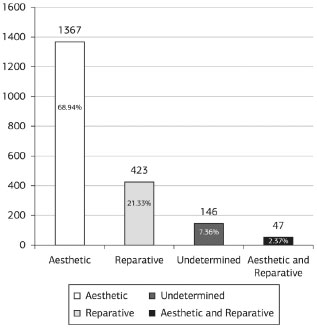
Figure 1. Characterization of the total news articles according to the plastic surgery concept in a 4-year period.
When we analyzed the classification of news per year, we observed that 286 news articles, in 2008, 493 in 2009, 331 in 2010, and 257 in 2011 could be classified as aesthetic. On the other hand, 94 in 2008, 99 in 2009, 104 in 2010, and 126 in 2011 were classified as reparative. In regard to the undetermined texts, there were 23 in 2008, 33 in 2009, 34 in 2010, and 56 in 2011. For the news articles classified as aesthetic and reparative, there were 13 in 2008, 18 in 2009, 7 in 2010, and 9 in 2011 (Figure 2).
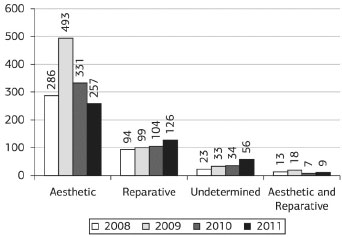
Figure 2. Characterization of the news articles per year according to the plastic surgery concept.
In regard to the geographic region where the news articles were published, in the northeast region, there were 324 articles classified as aesthetic, average of 81 ± 31.19, during the 4 years; on the other hand, 120 were classified as reparative, with an average of 30 ± 9.59.
In the northern region, there were 19 articles classified as aesthetic (average, 4.75 ± 3.77) and 24 as reparative (average, 6 ± 2.58). In the southeast region, there were 401 aesthetic (average, 100.25 ± 47.85) and 89 reparative (average, 22.25 ± 12.71). On the other hand, in the central-western region, 284 were aesthetic (average, 71 ± 20.80) and 88 reparative (average 22 ± 12.78). Finally, the southern region had 54 aesthetic (average, 13.5 ± 7.33) and 15 reparative (average, 3.75 ± 3.09) (Figure 3).

Figure 3. Geographical distribution according to the place where the news was published.
Among the cited surgical and nonsurgical procedures, we observed in the aesthetic texts that lipoaspiration had 236 (25%) citations, average 59 ± 9.86; mastoplasty had 195 (21%), average 48.75 ± 15.46; rhinoplasty had 74 (8%), average 18.5 ± 6.19; blepharoplasty had 56 (6%), average 14 ± 4.24; bioplasty had 19 (2%), average 4.75 ± 5.25; abdominoplasty had 31 (3%), average 7.75 ± 4.42; application of botulinum toxin had 76 (8%), average 19 ± 5.89; filling had 46 (5%), average 11.50 ± 6.80; lifting had 45 (5%), average 11.25 ± 8.26; gluteoplasty had 39 (4%), average 9.75 ± 3.59; and others had 114 (12%), average 28.5 ± 5.44 (Figure 4).
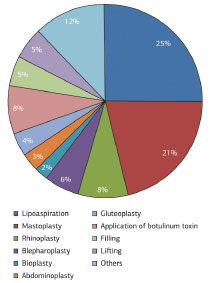
Figure 4. Most cited procedures, surgical or nonsurgical, classified as aesthetic in news articles.
When we analyzed the procedures described as reparative, the most cited procedures were as follows: breast reconstruction with 37 (18%) citations, average 9.25 ± 5.85; treatment of burns with 43 (21%) citations, average 10.75 ± 6.99; treatment of congenital deformities with 23 (11%) citations, average 5.75 ± 0.96, and others with 105 (50%) citations, average 26.25 ±10.72 (Figure 5).
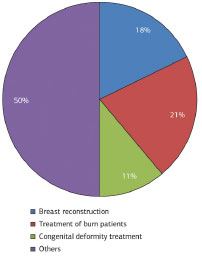
Figure 5. Most cited procedures, surgical or nonsurgical, classified as reparative in the news articles.
In regard to the remaining data used to characterize the articles according to the protocol, Table 1 shows the distribution of other elements analyzed during the 4 years of this study.
DISCUSSION
Plastic surgery has been mostly reported by the media in association with discourses about beauty and body ideals2,3,7-9. In our study, from the 1983 news articles published by the Brazilian print media, between January 2008 and December 2011, in which plastic surgery was mentioned, 1367 (68.94%) were aesthetic related. Reid and Malone4 had already demonstrated that 89% of the news in the United Kingdom related to plastic surgery demonstrated the specialty as having an aesthetic purpose.
In the articles classified as aesthetic related, there seems to be a greater concern from the media in showing, even if superficially, a relation between famous people and the aesthetic character of plastic surgery. We observed that, in the aesthetic category, there were 446 articles (32.62%) that cited famous people (average, 111.5 ± 62.56), during the 4 years of the study. This number is lower than the 52 (12.29%) news articles about reparative surgery in which famous people were cited (average 13.0 ± 7.0), as well as those classified as undetermined, and texts classified as aesthetic and reparative. We noted this same trend in the remaining classifications of news, when comparing aesthetic with reparative, aesthetic and reparative, and undetermined (Table 1).
It is possible that these findings were affected by the higher number of selected texts in the aesthetic category, a fact that could have rendered an increase in the remaining classification of news. However, even if this factor has an influence, the quantitative differences assessed in this study and the analysis of the discourse of each text suggest that, in the aesthetic texts, greater attention is given to the construction of the discourse that will be published. Elements that has an impact on the general public seem to be more frequently used in the aesthetic texts than in the remaining types, such as the citation of famous people, the risks and care associated with surgical procedures or not, and the presence of doctors (specialists or not). Although these elements are more present, they are not enough to clarify the large range of procedures a plastic surgeon can perform, and they contain superficial information about the topics discussed under the scope of the specialty.
According to the study by Reid and Malone4, two-thirds of the news articles analyzed reported the specialty as not having risks and did not mention complications. In our study, we found a similar result. Here, we observed a lower number of citations of the risks, surgical or not. In 337 news articles, representing less than half of the news analyzed, risks and care were mentioned.
Cronemberger et al.10 demonstrated that patients did not use information from the Internet in making the decision about whether to undergo the surgery or not, but to gather knowledge in order to mitigate the possible anxiety with regard to the procedure. In our study, it was noted that both the content and quality of the information made available by the print media, newspapers, and magazines are enough in regard to risks associated to surgery and care that should be taken when undergoing any type of procedure, either surgical or not. Therefore, even though this information may not influence the patient's decision, the content made available in the Brazilin media is not informative enough to solve possible doubts before performing surgical procedures.
It is possible that the aesthetical discourse associated with the specialty as reported by the media is linked to the commercialization of body ideals. The idea of the "perfect body" has become profitable in our society, as topics associated with beauty receive greater interest from readers. Articles related to these issues provide greater visibility to the newspapers or magazines, thus increasing their circulation and profit. This way, relating plastic surgery to this type of discourse is of more interest to the editorial board than publishing articles about the reparative type of surgery, as people associate the concept of deformity, rather than beauty, to the reparative type.
In regard to the geographical distribution of the news articles, we observed that there was a predominance of publication in the southeast and northeast regions. This finding might be related to the distribution of the population, with the southeast and northeast regions being the most populated in Brazil.11 Furthermore, it is possible that the greater expression in the southeast observed in our study is related to the fact that newspapers and magazines with a large nationwide circulation have their head office in this region.
Despite the higher absolute number of news articles published in these regions, our study does not present an analysis of the accessibility of the published information to the public; therefore, more studies are needed to more accurately determine the relation between the Brazilian regions and the publications of topics associated with plastic surgery, and the access that the public have to these news. Previous studies demonstrated that there is a relation between media, either printed or electronic, and the way the population accesses information and conceptualizes plastic surgery10,12. Agarwal12, in a study performed in India, showed that few people related plastic surgery to reparative treatments for conditions such as trauma, congenital deformities, cancer, and reconstructions, thus demonstrating that most people conceptualize the specialty as merely having an aesthetic purpose. In that study, print media (magazines or newspapers) and electronic media (television) were the main sources of information.
When we analyzed the most cited surgical and nonsurgical procedures in the news, we observed a predominance of citations related to lipoaspiration and mastoplasty, when compared to other procedures. It is possible that this finding is related to the number of these procedures performed in Brazil. The Instituto de Pesquisa Datafolha3 demonstrated that, from the 73% surgeries considered aesthetic in the country, 21% were augmentation mammoplasty, whereas 20% corresponded to lipoaspirations, with these two being the most often performed procedures. This way, despite the possibility of a statistical significance in the relation between the number of these procedures performed in Brazil and the number of citations in the media, new studies are required to clarify whether this possibility is due to a random event. Establishing more precise data would clarify the interactions between the plastic surgeon's role in the country and the interest behind the media in reporting.
In regard to the repair procedures, contrasting results were found in works by other authors4. In our study, breast reconstruction, treatment of burns, and treatment of congenital deformities were the most cited procedures. Reid and Malone4 showed that the procedures performed on trauma and burn patients were the most cited. It is possible that these differences are due to the designs of the studies. In our study, there was no previous determination of the type of reparative procedures that would possibly be detected, as the free demand of the text analysis led to the finding of the most cited procedures. Reid and Malone4 have previously determined that once the text is classified as repair related, it could be associated with procedures performed on patients with trauma, burn, infections, or oncologic problems.
CONCLUSION
We observed that the concept of plastic surgery as reported by the media is frequently associated with aesthetic procedures. Accordingly, the broad role that the specialty has in the correction of deformities affecting the human body is not usually reported. This is because the ideals of beauty and the search for body perfection are the aspects very well explored in the media. Both the content and quality of information provided by the media in regard to plastic surgery are not sufficient to adequately clarify to the public the true role of the specialty and the care that should be taken when undergoing any type of surgical treatment.
REFERENCES
1. Sociedade Brasileira de Cirurgia Plástica - SBCP. Dicionário de A a Z [Internet]. São Paulo: SBCP; 1998 [citado em 2014 Jul 12]. p. 6-7. Disponível em: http://www.cirurgiaplastica.org.br/dic/dicionario.html
2. Ribeiro RG, da Silva KS, Kruse MHL. O corpo ideal: a pedagogia da mídia. Rev Gaucha Enferm. 2009;30(1):71-6. PMid:19653558.
3. Datafolha. Cirurgia plástica no brasil [Internet]. 2009 [citado em 2014 Jul 12]. Disponível em: http://www2.cirurgiaplastica.org.br/
4. Reid AJ, Malone PS. Plastic surgery in the press. J Plast Reconstr Aesthet Surg. 2008;61(8):866-9. http://dx.doi.org/10.1016/j.bjps.2008.06.012. PMid:18675242.
5. Instituto Pró-Livro. Retratos da leitura no Brasil. 3a ed. São Paulo: Instituto Pró-Livro; 2011. p. 42.
6. US Media Consulting. Últimas estatísticas para as mídias brasileiras [Internet]. 2014 [citado em 2014 Jul 12]. Disponível em: http://brasillink.usmediaconsulting.com/2012/07/ultimas-estatisticas-para-as-a-midias-brasileiras/
7. Campana ANNB, Ferreira L, Tavares MCGCF. Associações e diferenças entre homens e mulheres na aceitação de cirurgia plástica estética no Brasil. Rev Bras Cir Plást. 2012;27(1):108-14. http://dx.doi.org/10.1590/S1983-51752012000100018.
8. Forster SS, Laing H. Plastic surgery in the press: is it all about nip and tuck? J Plast Reconstr Aesthet Surg. 2008;61(8):864-5. http://dx.doi.org/10.1016/j.bjps.2008.05.009. PMid:18675241.
9. Ribeiro LB. Cirurgia plástica estética em corpos femininos: a medicalização da diferença [Internet]. 2002 [citado em 2014 Jul 12]. Disponível em: http://www.antropologia.com.br/arti/colab/vram2003/a13-lbribeiro.pdf.
10. Cronemberger EV, Portocarrero ML, Donato AR, Cunha MS, Barreto TF, Meneses JVL. O uso da internet como fonte de informação sobre cirurgia plástica na Bahia, Brasil. Rev Bras Cir Plást. 2012;27(4):531-5. http://dx.doi.org/10.1590/S1983-51752012000400010.
11. Instituto Brasileiro de Geografia e Estatística - IBGE. Sinopse do Censo Demográfico 2010 [Internet]. 2011 [citado em 2014 Jul 12]. Disponível em: http://www.ibge.gov.br/home/presidencia/noticias/imprensa/ppts/0000000402.pdf.
12. Agarwal P. Perception of plastic surgery in the society. Indian J Plast Surg. 2004;37(2):110-4.
1. Hospital Universitário Professor Edgard Santos, Universidade Federal da Bahia (UFBA), Salvador, BA, Brazil
2. Escola Bahiana de Medicina e Saúde Pública, Salvador, BA, Brazil
Institution: Serviço de Cirurgia Plástica of the Hospital Universitário Professor Edgard Santos at the Universidade Federal da Bahia, Salvador, BA, Brazil.
Corresponding author:
Daniel Santos Corrêa Lima
Rua Dr. Raimundo Magaldi, 220 - Costa Azul
Salvador, BA, Brazil Zip Code 41760-020
E-mail dscorrealima@gmail.com
Article received: July 12, 2014
Article accepted: January 25, 2015


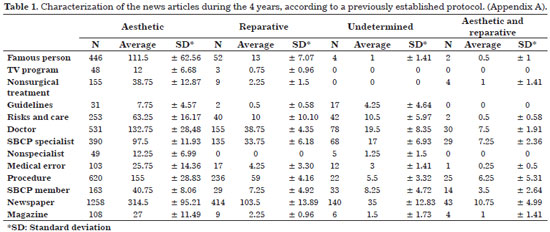
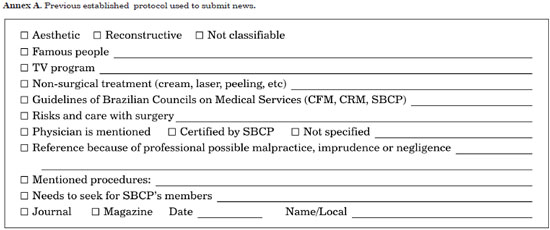
 Read in Portuguese
Read in Portuguese
 Read in English
Read in English
 PDF PT
PDF PT
 Print
Print
 Send this article by email
Send this article by email
 How to Cite
How to Cite
 Mendeley
Mendeley
 Pocket
Pocket
 Twitter
Twitter